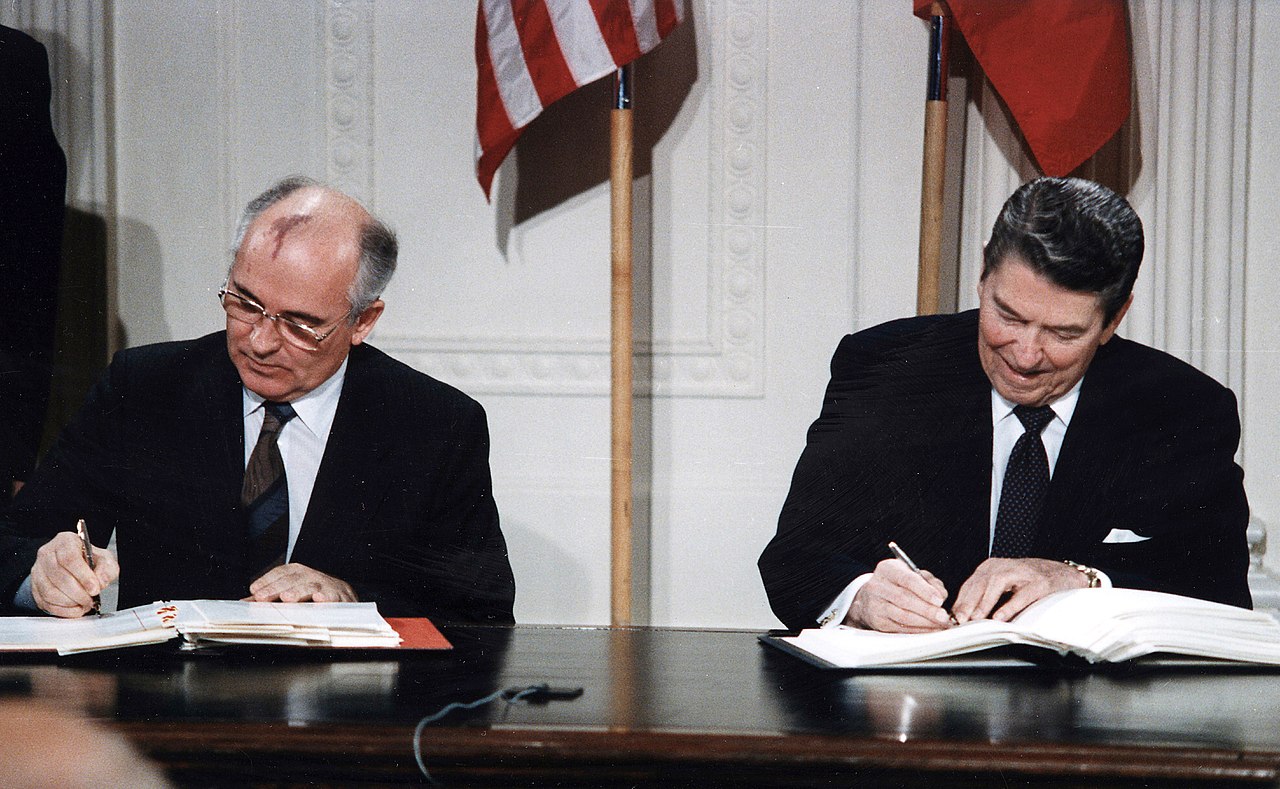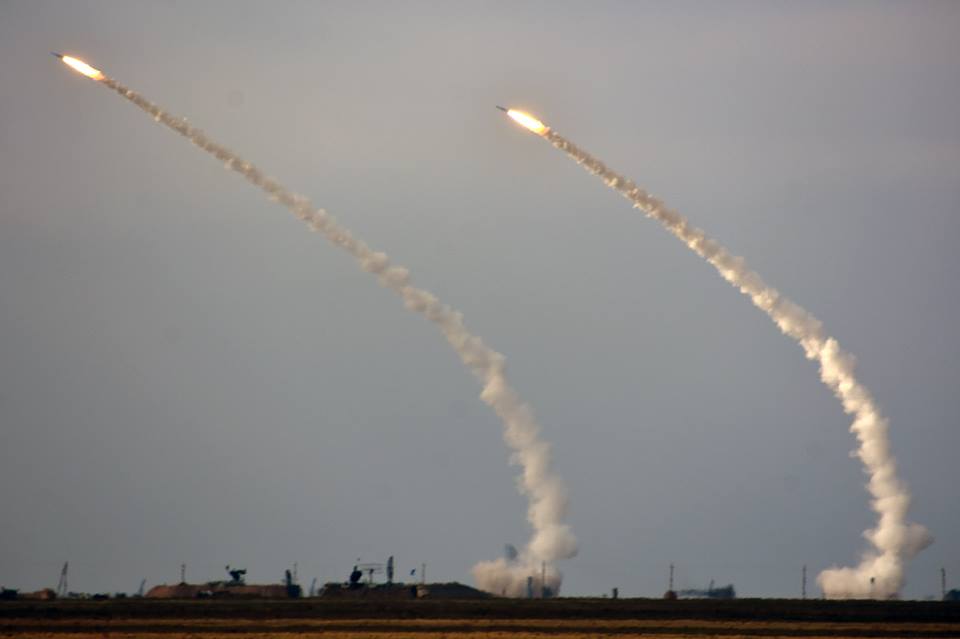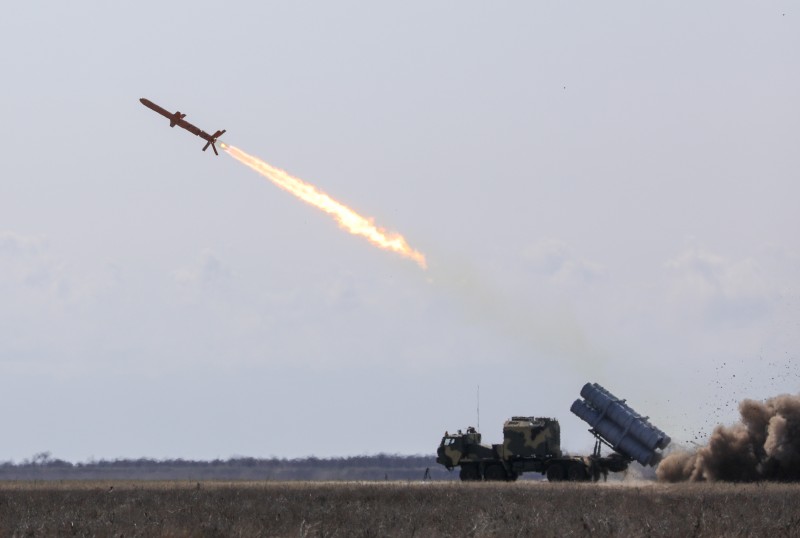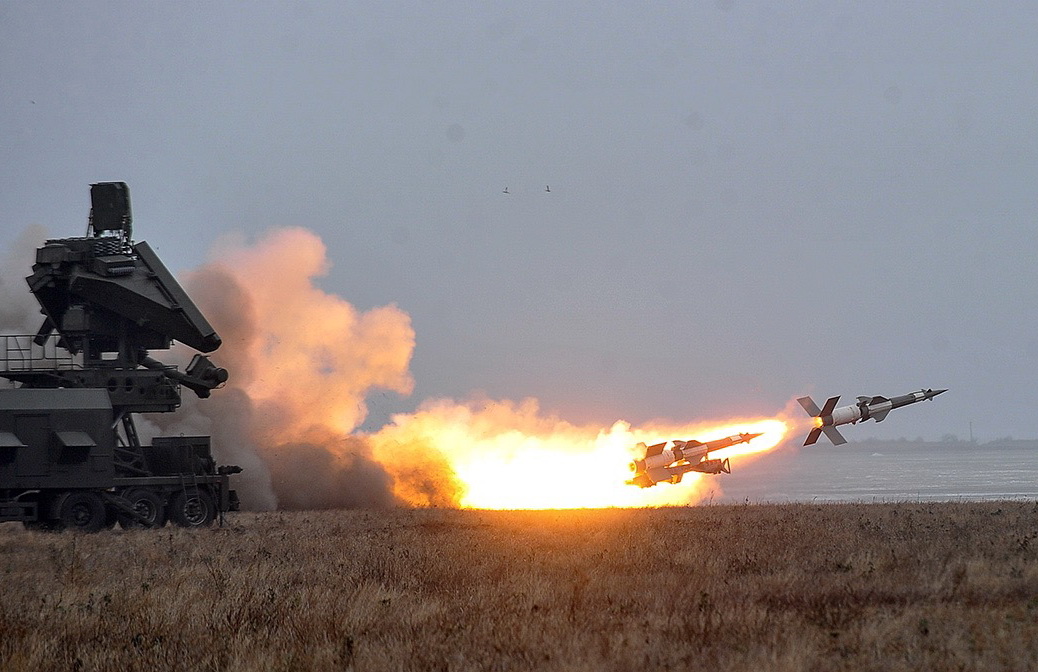The Intermediate-Range Nuclear Forces, or INF, Treaty is dead.
The key Cold War era disarmament agreement, signed by the United States and the Soviet Union in late 1987, was abandoned by both Washington and Moscow early this year. By August, when the final provisions of the treaty run out, the world’s two greatest missile powers will be free to design, produce, and deploy land-based missiles with ranges between 500 and 5,500 kilometers.
But the demise of the INF Treaty could give new life to Ukraine’s own missile forces – as an inheritor of the treaty’s obligations (it was signed when Ukraine was still part of the Soviet Union), Ukraine is also now free to develop and deploy its own shield of intermediate-range missiles.
And while Ukraine is not a nuclear power, a powerful missile force armed with conventional warheads could deter further Kremlin aggression: Russia is continuing its threatening military buildup in the occupied Ukrainian territory of Crimea and around the eastern borders of mainland Ukraine.
Ukraine’s leaders and diplomats have already said the nation reserves the right to expand its missile program. Experts say restoring the country’s missile power to deter Russia is doable, despite years of underfunding and neglect of the defense sector.
However, such a buildup is a major undertaking.
It will require a complete overhaul of the country’s defense production system, and intense scientific research, but even now Ukraine has almost all it needs to rise again as a missile power, including late Soviet production facilities, basic technologies, and specialists.
But strong political will be required to keep running and financing such an ambitious program for years in the future and finally rid the country of its dependence on outdated and decaying Soviet military stockpiles.
Arms race
The INF treaty, signed in Washington D.C. in December 1987 by the then Soviet and U.S. leaders, Mikhail Gorbachev and Ronald Reagan, was the most important arms reduction treaty signed during the Cold War.
The two superpowers, after years of negotiations, agreed to eliminate their land-based ballistic and cruise missiles with ranges of 500-1,000 kilometers (short medium-range) and of 1,000-5,500 kilometers (intermediate-range).
The treaty did not include sea- and airborne missiles, or intercontinental ballistic missiles (ICBMs). But it did help reduce tensions in Europe, which had been bristling with weapons at the time.
According to the U.S. Department of State, up to 2,692 missiles were verifiably eliminated by both parties by May 1991. After the fall of the Soviet Union, the treaty was resigned again in 1992, with Ukraine, Kazakhstan, Russia, and Belarus agreeing to abide by it.

Soviet Secretary General Mikhail Gorbachev (L) and U.S. President Ronald Reagan (R) sing the Intermediate-Range Nuclear Forces Treaty (INF) in Washington D.C. on Dec. 8, 1987. (Ronald Reagan Presidential Library)
But starting from 2008, the United States began accusing Russia of violating the agreement, particularly Moscow’s development and testing of the 9M729 (NATO reporting name SSC-8) missile for the Iskander-M systems.
According to Washington, the missile had an operational range of far more than 500 kilometers. Russians in their turn lambasted the Americans for deploying elements of the U.S. national missile defense system in Europe in the mid-2000s, as well as for the use of MQ-4 and MQ-9 strike drones and testing AGM-158 JASSM cruise missiles, which Moscow said were also violations of the INF treaty.
The years-long blame battle ended with United States suspending its observance of the treaty on Feb. 2, 2019. Russia did likewise in response the same day.
A new arms race began almost immediately – on Feb. 5, Russian Defense Minister Sergey Shoigu said that within next two years Russia will develop a land-based version of its seaborne Kalibr cruise missiles, which have ranges of up to 2,600 kilometers, as well as a brand new long-range land-based hypersonic missile system.
The treaty will expire on August 2019, six months after the mutual withdrawal of the parties.
Hands untied
Since becoming independent, Ukraine has honored the INF Treaty.
It backed the United States and denounced Russia for its development and tests of the RS-26 Rubezh (SS-X-31) ballistic missile, which, according to Ukraine’s Foreign Ministry, had an effective range of nearly 2,200 kilometers, and for upgrading the Iskander-M operational-tactical missile complexes, which had already been deployed to Russian-occupied Crimea.
But with the end of the treaty, as the ministry said on March 7, Ukraine will have a free hand to design new weapons that it was previously banned from developing.
“We’re no longer bound by any limitations, neither on the range of our missiles nor their power,” President Petro Poroshenko said on March 9.
“Let our enemy be aware of this too,” he added. “We need highly-precise missile ordnance, and we’re not going to repeat the mistakes of the Budapest Memorandum (of 1994 on security assurances by Russia, the United Kingdom, and the United States in exchange for Ukraine’s nuclear disarmament).”
This is no idle talk. Ukraine, which used to be home nearly 40 percent of the Soviet Union’s missile production capacity, still has the famous Pivdenmash plant (more commonly known as Yuzhmash) in the city of Dnipro some 400 kilometers southeast of Kyiv.
Though suffering severe decline for many years, the plant still makes spacecraft, rocket engines and rocket bodies, including the first stage of the Antares rocket, manufactured by U.S.-based aerospace giant Northrop Grumman.
Moreover, Ukraine still has another legend of space exploration and missile engineering — the Pivdenne design bureau (more commonly known as Yuzhnoye), which designed a number of famous rockets, such as the Zenit and Tsiklon rocket families, as well as the R-36 (SS-18 Satan) and R-16 (SS-7 Saddler) intercontinental ballistic missiles.
But even with the required engineers and production facilities, Ukraine’s future missile program still needs more to get it off the ground.

Zenit-3SL produced by rocket Ukraine’s Yuzhmash plant preparing to start from the Baikonur Cosmodrome in Kazakhstan.
Full production
The main problem is that despite being one of the main missile-building centers of the Soviet Union, Ukraine has never built a strategic missile system entirely by itself.
Some of the intermediate-range missiles banned under the INF treaty, such as the R-12 (SS-4 Sandal) and R-14 (SS-5 Skean) were co-produced by Yuzhmash. But the Dnipro plant was only part of a chain including many other enterprises, most located in present-day Russia.
So today Ukraine is still not able to launch full production of intermediate-range missiles, according to Anton Mikhnenko, the chief editor of the Kyiv-based Defense Express military technology journal.
“From a political and security perspective, Ukraine needs to have a weapon to deter Russia,” the expert told the Kyiv Post.
“If we want to have intermediate-range missiles like those we used to have in Soviet times, let’s say with ranges of 500-5,500 kilometers, we must understand that we need to have our own production and technical-material basis to maintain those missiles.”
And there’s also the issue of funding.
Even with a more or less developed design, Mikhnenko believes, running an intermediate-range missile program, including launching fully independent production, could cost up to $3-5 billion, and take up to 10 years.
Instead, the expert suggested enhancing the short-range missile projects that already exist or are under development in Ukraine, such as the RK-360MC Neptun cruise missile system, which was last successfully tested in early April.
The Neptun, designed by the Kyiv-based Luch Bureau as a land-based, anti-ship coastal defense missile with a range of 280 kilometers, could in future be upgraded with an improved guidance system, engine, and fuel.
Moreover, later Neptun versions will be ship-based, or air-launched by Sukhoi Su-24M attack jets.
Other operational-tactical systems – such as the 300-millimeter Vilkha missile system (with a range of 80-100 kilometers), or the Sapsan ballistic missile system, which has been under development on and off since 2009, and which has a range of up to 480 kilometers – could form a non-strategic deterrence force against Russia on the ground and at sea.
Deterrence weapon
Mykhailo Samus, the deputy director of the Center for Army, Conversion and Disarmament Studies, is more optimistic about Ukraine’s ability to relaunch production of intermediate-range missiles.
According to him, another promising project from the Yuzhnoye design bureau, the Hrim-2 ballistic missile system, which has a reported range of up to 500 kilometers, could potentially have its range extended to 1,000 kilometers.
As Samus says, as far back as the early 2000s, during the early stages of the Sapsan and Hrim projects, engineers at the Yuzhmash plant went to considerable lengths to plan a complete and independent production cycle for missiles in Ukraine.
However, at that time the Ukrainian leadership had no political will to allocate substantial funding for such a program.
Now, starting from the second half of 2019, once Ukraine is no longer bound by its INF obligations, the nation will have another launch window for a missile deterrence program.
“Nothing really prevents us from starting a new project, from determining what technical capabilities our missiles must have, and what we need to do to get this done,” Samus said.
“The Neptune in just one year made its way from an early prototype to a fully-performing end product,” he said. “In another year, I believe, the missile will start its combat alert duty, and this is very good progress. This means that for a missile (program), we already have engineers, production capacities and resources gathered together.”
If the Hrim-2 project is enhanced to ranges of 1,000 kilometers, it could form the intermediate-range ballistic missile component of Ukraine’s non-nuclear strategic deterrence shield.
For this, Ukrainian engineers could potentially reuse old Soviet designs for intercontinental ballistic missiles such as the R-36 (SS-18 Satan), which was produced at the Yuzhmash plant.
“In particular, an intercontinental ballistic missile engine could theoretically be used for intermediate- or short-range missiles,” Samus said.
“It’s very important to select the best-fit segment of the ballistic missiles we want to operate, in order to avoid diluting efforts.”
Ukraine would be best to operate one short medium-range cruise missile (such as the Neptun) with various modifications for all domains, and then also have ballistic missile defense system based on Hrim-2 missiles or other Soviet-based designs that would be easiest to produce and maintain, Samus said.
Such a non-nuclear deterrent could strike military targets such as headquarters, command communications, and ballistic and cruise missile silos located deep inside enemy territory, threatening unacceptable losses to an attacker.
“The longer the ranges (of the missiles), the better,” Samus said.
“The more distant the vital military targets in Russia we could precisely and powerfully hit, the less desire Russia will have to escalate a conflict to a critical point.”
Defending the skies
However, even an operation missile defense system would not be enough to ensure proper national defense.
Ukraine desperately needs effective missile defense systems capable of intercepting inbound Russian weapons, such as advanced Kalibr missiles.
Deployed in Russian-occupied Crimea, the Baltic and the Caspian seas, Kalibrs, with their range of 2,600 kilometers, could already strike any part of Ukraine’s territory, as could the Iskander-M systems deployed by the Russians in the enclave of Kaliningrad Oblast.
However, the good news is that Russia so far does not have the capability to mass-produce Kalibrs – it currently has about 100 of the missiles.
Before Russia gains the ability to make enough missiles for a massive missile strike, Ukraine will have to purchase and put into service a Western missile defense system – namely the famous U.S.-produced Patriot system, Samus said.
That’s because Ukraine’s increasingly outdating air defenses, based on upgraded Soviet S-300 and Buk-M1 systems, could be overwhelmed by a Russian attack of hundreds of missiles.
As far back as in late August 2018, the Ukraine’s ambassador to the United States, Valeriy Chaliy, said Kyiv could potentially buy three Patriot systems at a cost of $2.2 billion, but there has been no further progress on the initiative.
Samus said that before purchasing such sophisticated missile defense hardware, Ukraine would still need to develop a secure technology protection system in order to guarantee that information about advanced U.S. military hardware would not end up in Russian or Chinese hands.
But if obtained, wisely deployed Patriot systems, operated in coordination with an effective early warning radar system, would contribute greatly to preventing another Russian attack, Samus said.
“In all circumstances, any large-scale operation would commence with a radio-electric stage, followed by a missile strike, an aircraft attack, and, finally, a land and sea invasion,” he said.
“In order to reduce the possibility of such an operation, we need to exclude each of these elements. Land warfare is now our strongest side, so the Russians will not put boots on the ground without (first) degrading our air and missile defenses, and our command structure.”
“So a missile defense force is now the key to drastically reducing the likelihood of full-scale war.”





